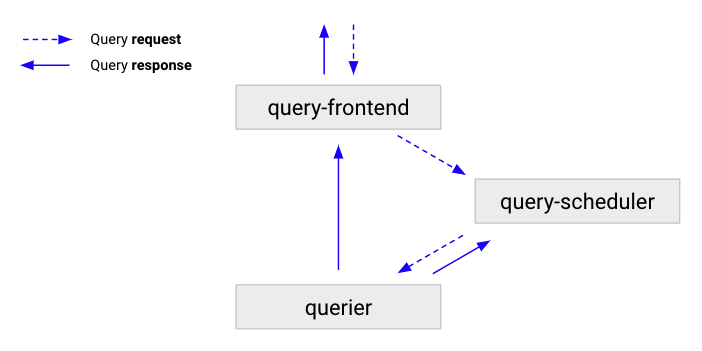Important: This documentation is about an older version. It's relevant only to the release noted, many of the features and functions have been updated or replaced. Please view the current version.
(Optional) Grafana Mimir query-scheduler
The query-scheduler is an optional, stateless component that retains a queue of queries to execute, and distributes the workload to available queriers.

The following flow describes how a query moves through a Grafana Mimir cluster:
- The query-frontend receives queries, and then either splits and shards them, or serves them from the cache.
- The query-frontend enqueues the queries into a query-scheduler.
- The query-scheduler stores the queries in an in-memory queue where they wait for a querier to pick them up.
- Queriers pick up the queries, and executes them.
- The querier sends results back to query-frontend, which then forwards the results to the client.
Benefits of using the query-scheduler
Query-scheduler enables the scaling of query-frontends. You might experience challenges when you scale query-frontend. To learn more about query-frontend scalability limits, refer to Why query-frontend scalability is limited.
How query-scheduler solves query-frontend scalability limits
When you use the query-scheduler, the queue is moved from the query-frontend to the query-scheduler, and the query-frontend can be scaled to any number of replicas.
The query-scheduler is affected by the same scalability limits as the query-frontend, but because a query-scheduler replica can handle high amounts of query throughput, scaling the query-scheduler to a number of replicas greater than -querier.max-concurrent is typically not required, even for very large Grafana Mimir clusters.
Configuration
To use the query-scheduler, query-frontends and queriers need to discover the addresses of query-scheduler instances. The query-scheduler supports two service discovery mechanisms:
- DNS-based service discovery
- Ring-based service discovery
DNS-based service discovery
To use the query-scheduler with DNS-based service discovery, configure the query-frontends and queriers to connect to the query-scheduler:
- Query-frontend:
-query-frontend.scheduler-address - Querier:
-querier.scheduler-address
Note: The configured query-scheduler address should be in the
host:portformat. If multiple query-schedulers are running, the host should be a DNS resolving to all query-scheduler instances.
Note: The querier pulls queries only from the query-frontend or the query-scheduler, but not both.
-querier.frontend-addressand-querier.scheduler-addressoptions are mutually exclusive, and only one option can be set.
Ring-based service discovery
To use the query-scheduler with ring-based service discovery, configure the query-schedulers to join their hash ring, and the query-frontends and queriers to discover query-scheduler instances via the ring:
- Configure the hash ring for the query-scheduler.
- Set
-query-scheduler.service-discovery-mode=ring(or its respective YAML configuration parameter) to query-scheduler, query-frontend and querier. - Set the
-query-scheduler.ring.*flags (or their respective YAML configuration parameters) to query-scheduler, query-frontend and querier.
Migrate from DNS-based to ring-based service discovery
To migrate the query-scheduler from DNS-based service discovery to ring-based service discovery, perform the following steps:
Configure the query-scheduler instances to join a ring:
-query-scheduler.service-discovery-mode=ring # Configure the query-scheduler ring backend (e.g. "memberlist"). -query-scheduler.ring.store=<backend> # If the configured <backend> is "memberlist", then ensure memberlist is configured for the query-scheduler. -memberlist.join=<same as other Mimir components> # If the configured <backend> is "consul" or "etcd", then set their backend configuration # for the query-scheduler ring: # - Consul: -query-scheduler.ring.consul.* # - Ecd: -query-scheduler.ring.etcd.*Wait until the query-scheduler instances have completed rolling out.
Ensure the changes have been successfully applied; open the query-scheduler ring status page and ensure all query-scheduler instances are registered to the ring. At this point, queriers and query-frontend are still discovering query-schedulers via DNS.
Configure query-frontend and querier instances to discover query-schedulers via the ring:
-query-scheduler.service-discovery-mode=ring # Remove the DNS-based service discovery configuration: # -query-frontend.scheduler-address # Configure the query-scheduler ring backend (e.g. "memberlist"). -query-scheduler.ring.store=<backend> # If the configured <backend> is "memberlist", then ensure memberlist is configured for the query-scheduler. -memberlist.join=<same as other Mimir components> # If the configured <backend> is "consul" or "etcd", then set their backend configuration # for the query-scheduler ring: # - Consul: -query-scheduler.ring.consul.* # - Ecd: -query-scheduler.ring.etcd.*
Note: If your Mimir cluster is deployed using Jsonnet, see Migrate query-scheduler from DNS-based to ring-based service discovery.
Operational considerations
For high-availability, run two query-scheduler replicas.
If you’re running a Grafana Mimir cluster with a very high query throughput, you can add more query-scheduler replicas.
If you scale the query-scheduler, ensure that the number of replicas you add is less or equal than the configured -querier.max-concurrent.




